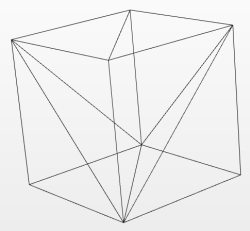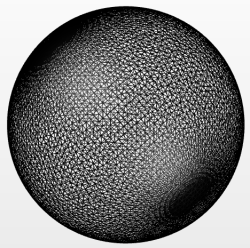B-rep and Tessellation
Three dimensional models are represented in different ways. Two methods SpinFire Ultimate uses are B-rep and Tessellation. There are advantages and disadvantages to each method of representation.
Definitions
Tessellation
Tessellation is the representation of a 3D object with a mesh of straight lines. These straight lines form geometric shapes. SpinFire Ultimate and other CAD formats use triangles. Surfaces are drawn quickly from tessellated data depending on the complexity of the surfaces. The more triangles that are needed the more information must be stored and retrieved and drawn. Curved surfaces increase the complexity.
Imagine representing a simple cube with a set of triangles. Perhaps you would simply need two triangles per side requiring you to only need to draw 2 x 6 triangles. This is quick and simple.
Now imagine representing a sphere with a set of triangles. With a handful, the sphere may look round-ish but would have obvious "dents" due to the straight lines and flat surfaces. Using more triangles would add more curvature and lessen the size of the flat surfaces. The more triangles added, the rounder the sphere appears.

The number of triangles also plays into the precision of measurements of the model. Imagine calculating the surface area of the sphere represented on the left versus the one on the right.
B-rep
B-rep is the common name for Boundary Representation. B-rep represents models with precise geometry and boundary topology.
This allows complex shapes to be represented precisely which helps
- combining shapes,
- measuring physical properties with accuracy, and
- smaller file representation.
When SpinFire Ultimate renders B-rep models, it must convert the models to some tessellated representation resulting in slight performance hits.
For the above sphere example, B-rep would need a center point and a radius stored to represent it. However, to render it on screen would be slightly longer due to the conversion.
The main difference is that due to precise mathematical representation, calculations such as volume, surface area, curvature, edge length etc... will be more accurate compared to using the tessellated data. Actify uses B-rep in several measurements now in SpinFire.
File Types
Some native CAD file formats support B-rep others do not. SpinFire Ultimate offers the following support based on the native format's support of B-rep and Actify's ability to import B-rep.
| File Format | Supports B-rep |
|---|---|
| AutoCAD 3DS Max | |
| AutoCAD DWG | |
| AutoCAD DXF | |
| AutoCAD DWF | |
| ACIS (SAT) | |
| Catia V4 | |
| Catia V5 | |
| Catia V6 | |
| Collada | |
| FBX | |
| gITF | |
| I-deas | |
| IGES | |
| IFC | |
| Inventor | |
| JT | |
| NX | |
| Parasolid | |
| 3D PDF | |
| PRC | |
| Pro/Engineer & Creo Parametric | |
| Revit | |
| Rhino | |
| Solid Edge | |
| SolidWorks | |
| STEP | |
| STL | |
| VDA-FS | |
| U3D | |
| VRML |
Advantages and Disadvantages Summary
| Action | Tessellation | B-rep |
|---|---|---|
| Accurate Measurements | ||
| Smaller File Sizes for Complex Models | ||
| Quick Rendering (displaying) | ||
